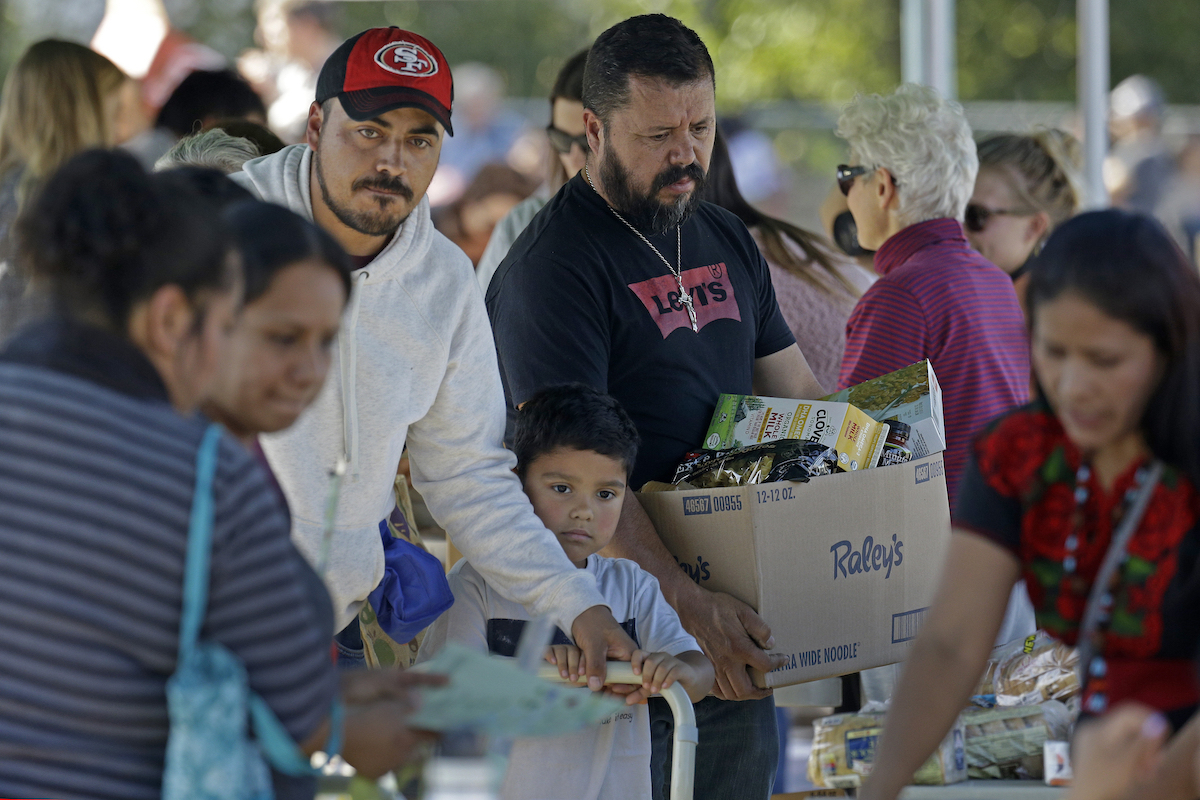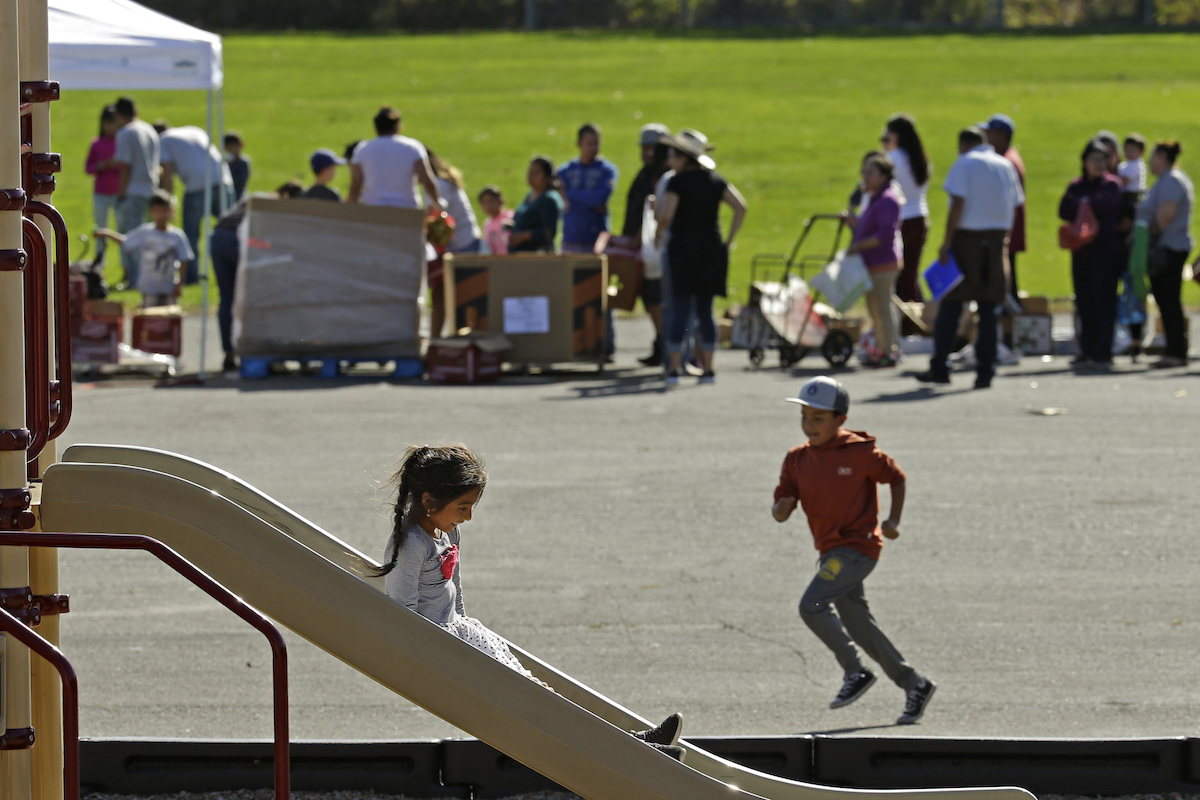

People gather items during a free food distribution for migrant workers evacuated because of the Kincade Fire Thursday, Oct. 31, 2019, in Healdsburg, Calif. (AP Photo/Charlie Riedel)
By JOHN MONE and ASTRID GALVÁN, Associated Press
HEALDSBURG, Calif. (AP) — Two years ago, when fires ravaged Northern California, where tens of thousands Latinos in the U.S. illegally work at farms and vineyards, displaced families were seen sleeping on beaches or in their cars.
Farmworkers, construction workers and others in the service industry stayed away from evacuation centers for fear that immigration authorities would use the crisis as an opportunity to detain and deport people.
As another massive fire burns the same area this week, it’s been a very different story, according to immigrants and community groups that work closely with them.
Translators and aid workers have been at evacuation centers, interviewing families and scouting out items they need, like baby formula, diapers or medication. Groups are raising funds and distributing cash for those out of work.
Local governments and California fire officials have increased bilingual outreach, posting social media updates in both languages. They also have told people that Immigration and Customs Enforcement won’t have access to any shelters, trying to allay fears of an immigration raid.
“It was great because all these people were comfortable coming to these evacuation centers and it was something good to see,” said Cal Fire spokesman Edwin Zuniga, who is bilingual and has been leading Spanish-language press conferences. “It made me feel good that these people felt safe and it made me feel good that I was able to give them this information in Spanish and reach out to them.”
The fire burning in Sonoma County has forced over 180,000 to evacuate, has burned 167 homes and has grown to 121 square miles (313 square kilometers). Most of those evacuated have been allowed to return home, but they face power outages after California’s biggest utility, Pacific Gas & Electric, has again imposed blackouts.
Roughly 38,000 immigrants without legal status and 6,000 temporary farmworkers are in the county, advocacy groups say, and they’ve been able to help some 5,500 families, totaling about 20,000 people.
Diana Solis, of Windsor, was grateful for access to information. Solis, who doesn’t have legal status, was picking grapes for a winery on Saturday when her boss told her to evacuate. Her car broke down on her way to pick her 2-year-old son up, and it would be hours before they landed at a shelter in Marin County. There, firefighters came by twice a day to provide the latest updates in Spanish, Solis said.
Labor and immigrant advocates say the way the government has handled communication with the Spanish-speaking communities has vastly improved since the 2017 wildfire, which claimed 22 lives and destroyed over 5,600 structures.
The slower speed of the fire has helped this time around.
In 2017, the fire struck in the middle of the night and moved quickly, so there was little time to prep. This year’s so-called Kincade Fire spread less quickly, giving authorities more time to organize evacuations, communicate options and assuage fears.
Zuniga said his agency had learned from the 2017 fire, when it didn’t do initial outreach in Spanish and many expressed fear of going to shelters over their immigration status. Zuniga said that this time around, Spanish-language messaging was delivered from the very beginning, and he’s seen a difference in how the immigrant community has responded.
Still, families who don’t speak English face hurdles.
On Tuesday, a family with a 4-week-old baby was at a shelter struggling to find diapers and formula, said Mara Ventura, executive director of North Bay Jobs with Justice.


Children play on the playground while people line up for a free food distribution for migrant workers evacuated because of the Kincade Fire Thursday, Oct. 31, 2019, in Healdsburg, Calif. (AP Photo/Charlie Riedel)
Ventura said the mother told her there was no privacy to nurse and the family hadn’t been able to get to a store because of the power outage. The evacuation order was lifted in the family’s neighborhood, but nobody had told them. Ventura gave the family some money and helped them home.
Gabriela Orantes, with the North Bay Organizing Project, said some immigrants may still fear encountering authorities at shelters, one reason her organization and others have tried to offer support.
Orantes said outreach in schools and government efforts to be more inclusive of Spanish speakers have worked well, but that migrants still lack access to resources. She said the news conference that was held in Spanish was a summary of the English-language one, and didn’t include all the specific details of the original.
“In that respect there’s still a second-class citizen response that I feel is still happening,” Orantes said.
Lupe Arias, a Mexican immigrant who lives in Healdsburg and works in packaging for a local winery, said she’s been keeping up with the latest through Cal Fire’s Facebook page, where the agency is posting Spanish-language video updates daily, and through text alerts. Arias, who lacks legal status, and her husband and three kids had to leave on Saturday, staying with relatives in San Francisco, but planned on returning home by Wednesday night after the evacuation order was lifted.
They’ve so far gone a week without pay —about $1,400 in wages from the three jobs they hold between two of them— and will likely have to borrow from friends to pay for food and rent.
“This impacts me because as you know we live off what we earn every day,” Arias said.
The harvest season is winding down but not over, and many temporary farmworkers won’t able to finish their jobs, so cash is tight and some will have to live in California or return to Mexico without the savings they expected.
Solis, a single mother, was worried about how she’d pay rent on Friday, having missed several days of work. She said she’d likely ask friends to loan her money until she’s back on her feet.
“I still don’t know what to do. It’s stressful,” Solis said through tears.


